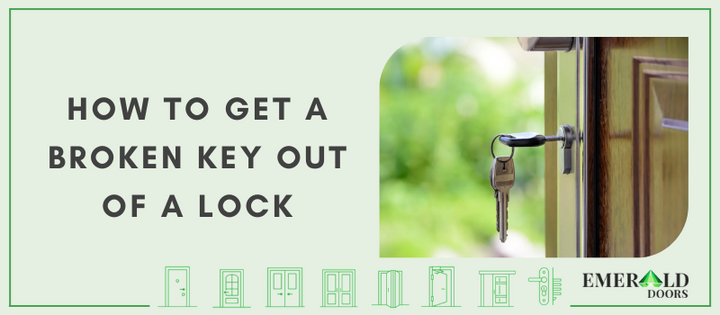
How to Get a Broken Key Out of a Lock
Finding yourself with a broken key stuck in a door lock can be incredibly frustrating and inconvenient, especially when you're in a rush. This common issue can disrupt your plans, leaving you feeling helpless and stressed as you struggle how to get a broken key out of a lock and regain access to your home.
But, fear not—several effective solutions can help you with your broken key extraction process. Read on to explore practical methods to resolve this problem efficiently, if you have a broken key inserted.
To begin with, you’ll need some advanced tools for removing the broken key from the lock:
- Lubricant
- Needle Nose Pliers or Tweezers
- Paperclips or Bobby Pins
- Jigsaw or Hacksaw Blade
- Glue Stick
- Magnets
- Key Extractor Tools
Steps to Remove a Broken Key
With the right tools on hand, follow the various steps mentioned below to successfully extract the broken key from a lock.
Lubricate the Lock
Apply a generous amount of lubricant, such as WD-40, into the lock. This reduces friction, making it easier to slide the broken key piece out. Allow a few minutes for the lubricant to settle and penetrate the lock mechanism. This step is crucial as it prepares the lock for easier manipulation and extraction of the broken key.
Needle Nose Pliers or Tweezers
If part of the broken key is protruding from the lock, gently grasp it with needle nose pliers or tweezers. Carefully pull the key out, ensuring not to push it further into the lock. Using too much force can damage the lock, so proceed with caution.
Paperclips or Bobby Pins
Straighten a paperclip or bobby pin and insert it alongside the broken key piece. Try to hook the end of the key with the paperclip or bobby pin and slowly pull it out. This method is useful for keys stuck deeper within the lock. It might take a few attempts to get the right angle, so be patient.
Jigsaw or Hacksaw Blade
Take a thin jigsaw or hacksaw blade and slide it into the lock alongside the broken key. Twist and pull gently to catch and extract the key piece. Ensure the blade’s teeth face outward to grip the key effectively. This method is particularly effective for deeply lodged key pieces but requires a steady hand to avoid damaging the lock.
Glue Stick
Heat the end of a glue stick until it becomes soft. Press it against the broken keypiece and allow it to cool and harden. Once the glue adheres to the key, pull the stick out slowly, bringing the key piece with it. This technique works best for keys that are not too deeply embedded and require patience as the glue cools.
Magnets
If the broken key is made of ferrous metal, a strong magnet can sometimes help. Position the magnet near the key and slowly pull it out. This method works best for shallowly embedded keys. It might not work if the key is stuck too deeply or if the lock mechanism is interfering with the magnet’s pull.
Key Extractor Tools
Broken key extractor tools are designed for this purpose and are usually available at almost every hardware store. Insert the extractor into the lock and twist it to hook onto the broken key piece. Gently pull it out once it’s securely attached. These key extractors are highly effective and designed to minimize damage to the lock, especially in this broken key situation.
How To Prevent Broken Keys
To prevent broken keys:
- Use High-Quality Keys and Locks: Invest in durable keys and locks to reduce the risk of breakage. High-quality materials are less likely to wear down and break.
- Avoid Excessive Force: Never force a key to turn in a lock. If it resists, check if the lock or key is misaligned. Forcing it can cause the key to snap.
- Regular Maintenance: Lubricate locks periodically to keep them functioning smoothly and prevent internal wear and tear. Regular maintenance extends the life of your lock and key.
- Replace Worn Keys: If a key shows signs of wear, replace it before it breaks inside the lock. A key with visible damage or bending is a candidate for replacement.
When To Call A Professional Locksmith
Sometimes, despite your best efforts, removing a broken key might be beyond your capability. If the key is deeply embedded or the lock mechanism is damaged, it’s best to call a professional locksmith. Locksmiths have specialized tools and expertise to extract broken keys without damaging the lock further. The cost for a locksmith can range from £80 to £100, depending on the complexity of the job and the time of day. Calling a professional is advisable when DIY methods fail to get a broken key out, or if you risk damaging an expensive or critical lock.
Get High-Quality Doors and Locks
Using high-quality locks and taking preventive measures can prevent key breakage and lock stuck. For durable locks, consider purchasing from Emerald Doors’ door locks collection. Investing in superior locks can prevent frustrating incidents with new keys and Ensure long-term security.
Emerald Doors also offers a variety of high-quality internal doors and external doors for your home or office, ensuring both security and aesthetic appeal.